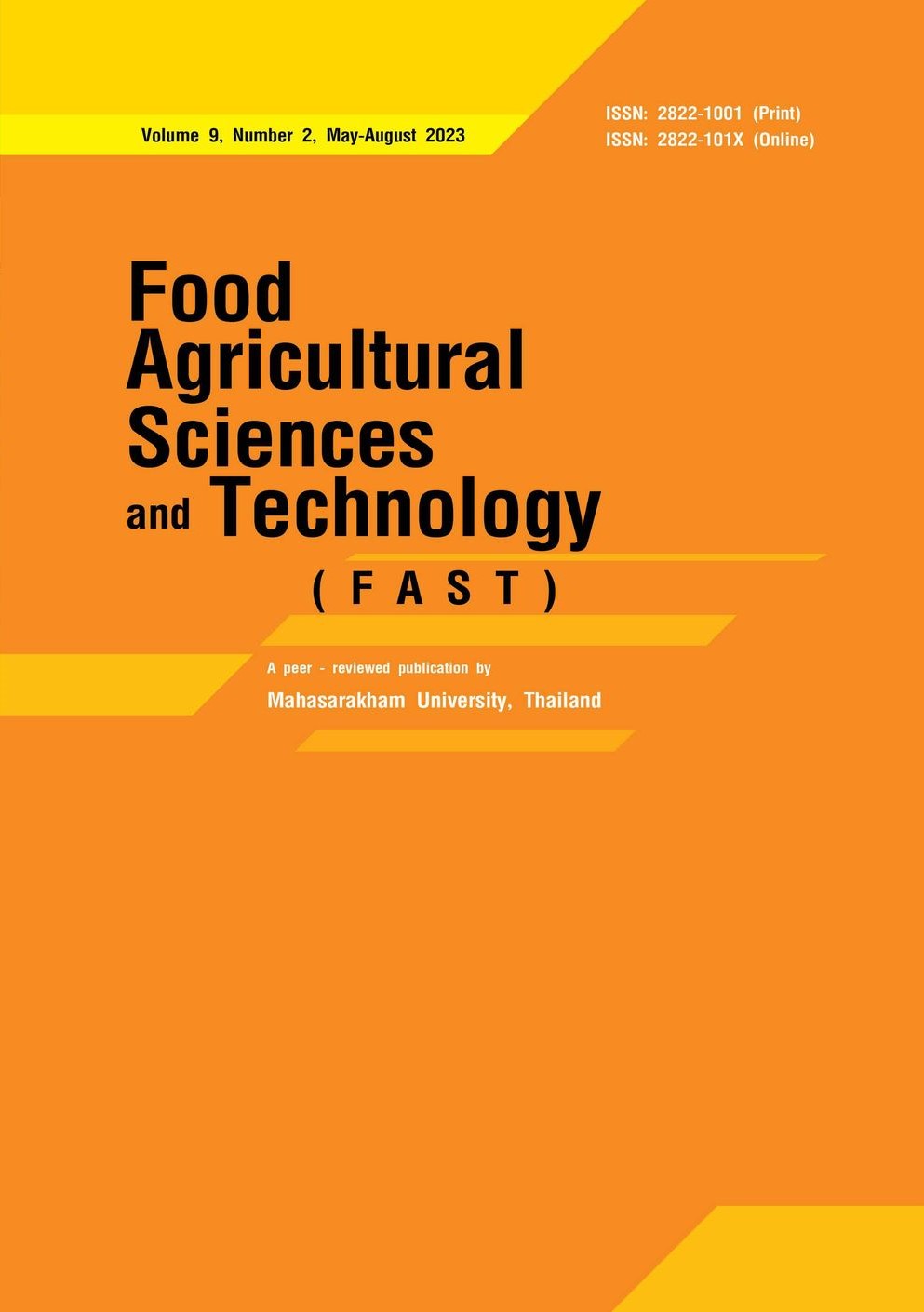Comparison the stability and physical properties of salad dressing obtained with egg yolk and gelatin
Keywords:
Salad dressing, Emulsifier, egg yolk, gelatin, stabilityAbstract
Emulsifiers are essential for emulsion formation and stabilization. Egg yolk and gelatin play an important role as effective emulsifiers in salad dressing. This study aimed to examine the impacts of different emulsifiers, including egg yolk (EY), gelatin (GE), and combination of egg yolk and gelatin (YG) on emulsion stability and selected physical properties of salad dressings. The results showed that GE-salad dressing showed the highest emulsion stability, followed with YG-emulsified salad dressing during 14 days of storage at room temperature. The separated serum layer at a bottom phase were observed for EY- and control-salad dressing, indicating instability of emulsion. GE-emulsified sample exhibited the higher lightness and whiteness and lower redness and yellowness than EY-emulsified sample (p≤0.05). YG-emulsified salad dressing had the highest viscosity (p≤0.05). From the microscopic results, all formulations presented a visible increase in the drop size throughout the storage period. GE- and YG-emulsified samples remained stable and protected them against creaming, flocculation, and coalescence. Emulsifiers had a strong influence on the structure and physical stability. The egg yolk and gelatin used to stabilize the dressing-type emulsions are additively promising in microstructured food design.
References
Anton, M. (2013). Egg yolk: structures, functionalities and processes. Journal of the Science of Food and Agriculture, 93(12), 2871-2880.
Anton, M., Beaumal, V., & Gandemer, G. (2000). Adsorption at the oil-water interface and emulsifying properties of native granulesfrom egg yolk: effect of aggregated state. Food Hydrocolloids, 14, 327-335.
Ataie, M. J., Shekarabi, S. P., & Jalili, S. H. (2019). Gelatin from bones of bighead carp as a fat replacer on physicochemical and sensory properties of low-fat mayonnaise. Journal of Microbiology, Biotechnology and Food Sciences, 8(4), 979-983.
Balnave, D., & Bird, J. N. (1996). Relative efficiencies of yellow carotenoids for egg yolk pigmentation. Asian-Australas J Anim Sci, 9(5), 515-518.
Bouyer, E., Mekhloufi, G., Le Potier, I., de Kerdaniel Tdu, F., Grossiord, J. L., Rosilio, V., & Agnely, F. (2011). Stabilization mechanism of oilin-water emulsions by β-lactoglobulin and gum arabic. J Colloid Interface Sci, 354(2), 467-477.
De Cássia da Fonseca, V., Haminiuk, C. W. I., Izydoro, D. R., Waszczynskyj, N., De Paula Scheer, A., & Sierakowski, M.R. (2009). Stability and rheological behaviour of salad dressing obtained with whey and different combinations of stabilizers. International Journal of Food Science & Technology, 44(4), 777-783.
Dickinson, E. (1992). An Introduction to Food Colloids. 207 Seiten, zahlr. Abb. In J. Kroll (Ed.), Food / Nahrung (Vol. 36, pp. 514-514). John Wiley & Sons, Ltd. https:// doi.org/10.1002/food.19920360540
Dickinson, E. (2009). Hydrocolloids as emulsifiers and emulsion stabilizers. Food Hydrocolloids, 23(6), 1473- 1482.
Dickinson, E., & López, G. (2001). Comparison of the emulsifying properties of fish gelatin and commercial milk proteins. Journal of Food Science, 66, 118-123.
Diftis, N. G., Biliaderis, C. G., & Kiosseoglou, V. D. (2005a). Rheological properties and stability of model salad dressing emulsions prepared with a dry-heated soybean protein isolate-dextran mixture. Food Hydrocolloids, 19(6), 1025-1031.
Diftis, N. G., Pirzas, T. A., & Kiosseoglou, V. D. (2005b). Emulsifying properties of gelatin conjugated to pectin under alkaline conditions. Journal of the Science of Food and Agriculture, 85(5), 804-808.
Gómez-Guillén, M. C., Pérez-Mateos, M., Gómez-Estaca, J., López-Caballero, E., Giménez, B.& Montero, P. (2009). Fish gelatin: a renewable material for developing active biodegradable films. Trends in Food Science & Technology, 20(1), 3-16.
Hee, L., Jacquot, M., Hardy, J., and Desobry, S. (2008). Formulating polymeric gels simulating soft cheeses’ texture. Food Hydrocolloids, 22(5), 925-933.
Hesarinejad, M. A., Lorenzo, J. M.& Rafe, A. (2021). Influence of gelatin/guar gum mixture on the rheological and textural properties of restructured ricotta cheese. Carbohydrate Polymer Technologies and Applications, 2, 100162.
Hoffmann, H., & Reger, M. (2014). Emulsions with unique properties from proteins as emulsifiers. Adv Colloid Interface Sci, 205, 94-104.
Karim, A. A., & Bhat, R. (2009). Fish gelatin: properties, challenges, and prospects as an alternative to mammalian gelatins. Food Hydrocolloids, 23(3), 563-576.
Kilpatrick, P. K. (2012). Water-in-Crude oil emulsion stabilization: Review and unanswered questions. Energy & Fuels, 26(7), 4017-4026.
Lee, C. H., & Chin, K. B. (2022). Effect of pork skin gelatin on the physical properties of pork myofibrillar protein gel and restructured ham with microbial transglutaminase. Gels, 8(12), 882.
Liu, X., Guo, J., Wan, Z.-L., Liu, Y.-Y., Ruan, Q.-J., & Yang, X.-Q. (2018). Wheat gluten-stabilized high internal phase emulsions as mayonnaise replacers. Food Hydrocolloids, 77, 168-175.
Ly, B. C. K., Dyer, E. B., Feig, J. L., Chien, A. L., & Del Bino, S. (2020). Research techniques made simple: Cutaneous colorimetry: A reliable technique for objective skin color measurement. Journal of Investigative Dermatology, 140(1), 3-12.e11.
McClements, D. J., Bai, L., & Chung, C. (2017). Recent advances in the utilization of natural emulsifiers to form and stabilize emulsions. Annu Rev Food Sci Technol, 8, 205-236.
McClements, D. J., & Demetriades, K. (1998). An integrated approach to the development of reduced-fat food emulsions. Crit Rev Food Sci Nutr, 38(6), 511-536.
McClements, D. J., & Gumus, C. E. (2016). Natural emulsifiers — Biosurfactants, phospholipids, biopolymers, and colloidal particles: Molecular and physicochemical basis of functional performance. Adv Colloid Interface Sci, 234, 3-26.
Milliatti, M., & Lannes, S. (2018). Impact of stabilizers on the rheological properties of ice creams. Food Science and Technology, 38, 733-739.
Nimalaratne, C., Wu, J., & Schieber, A. (2013). Egg Yolk Carotenoids: composition, analysis, and effects of processing on their stability. In Carotenoid Cleavage Products (Vol. 1134, pp. 219-225). American Chemical Society. https://doi.org/ doi:10.1021/bk-2013-1134.ch018
Paraskevopoulou, D., Boskou, D., & Paraskevopoulou, A. (2007). Oxidative stability of olive oil-lemon juice salad dressings stabilized with polysaccharides. Food Chemistry, 101(3), 1197-1204.
Sanmartín, B., Díaz, O., Rodríguez-Turienzo, L., & Cobos, A. (2018). Emulsion characteristics of salad dressings as affected by caprine whey protein concentrates. International Journal of Food Properties, 21(1), 12-20.
Sirison, J., Rirermwong, A., Tanwisuit, N., & Meaksan, T. (2017). Salad cream formulated with tofu and coconut oil. British Food Journal, 119(10), 2194-2202.
Triawati, N. W., Radiati, L. E., Thohari, I., & Manab, A. (2016). Microbiological and physicochemical properties of mayonnaise using biopolymer of whey protein-gelatin-chitosan during storage. International Journal of Current Microbiology and Applied Sciences, 5(7), 191-199.
Villegas, R., O’Connor, T. P., Kerry, J. P., & Buckley, D. J. (1999). Effect of gelatin dip on the oxidative and colour stability of cooked ham and bacon pieces during frozen storage. International Journal of Food Science & Technology, 34(4), 385-389.
Williams, P. A., Phillips, G. O., & Dickinson, E. (2006). Effect of hydrocolloids on emulsion stability. In G. O. Phillips & P. A. Williams (Eds.), Gums and Stabilisers for the Food Industry 12 (pp. 394-404). The Royal Society of Chemistry. https://doi. org/10.1039/9781847551214-00394
Yang, S. C., & Chen, K. H. (2001). The oxidation of cholesterol in the yolk of selective traditional Chinese egg products. Poult Sci, 80(3), 370-375.
Zhang, T., Ding, M., Tao, L., Liu, L., Tao, N., Wang, X., & Zhong, J. (2020). Octenyl succinic anhydride modification of bovine bone and fish skin gelatins and their application for fish oil-loaded emulsions. Food Hydrocolloids, 108, 106041.
Downloads
Published
How to Cite
Issue
Section
License
Copyright (c) 2023 Food Agricultural Sciences and Technology (FAST)

This work is licensed under a Creative Commons Attribution-NoDerivatives 4.0 International License.







